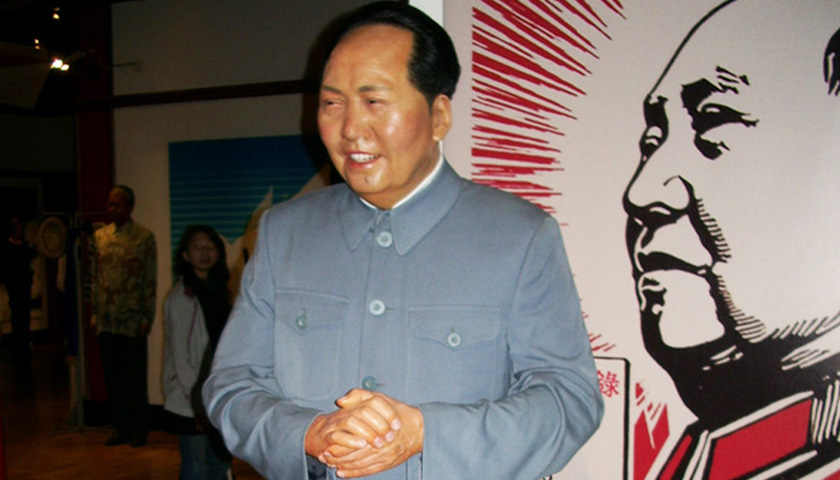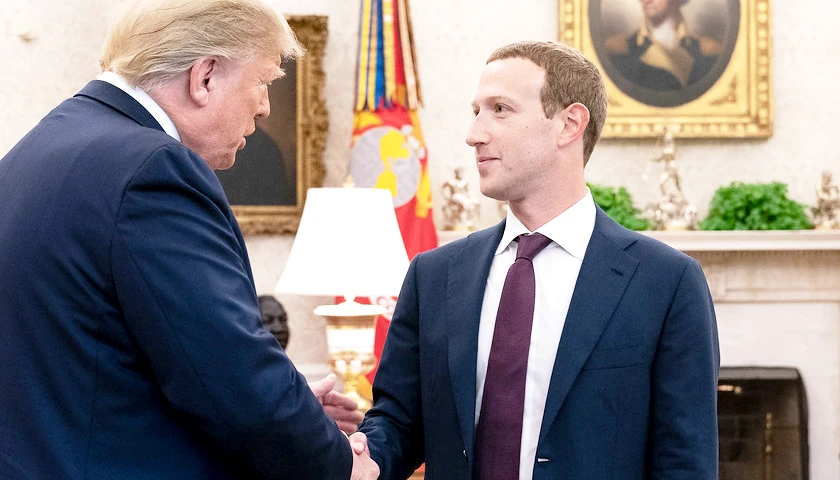by Bruce Oliver Newsome
Wokeism is conventionally traced back through progressivism and Marxism to the fake liberalism of Jean-Jacques Rousseau. The histories of wokeism have failed to focus on Maoism, even though some observers noticed the similarity between Mao Zedong’s cultural revolution of the late 1960s and the West’s cultural revolution of the late 2010s.
In 1966, China’s students rallied for “rebellion,” against “reactionary” teachers and courses, and against Mao’s “four olds” (old ideas, old culture, old customs, old habits).
Then came the witch hunts, show trials, groveling apologies for vague crimes, over-compensatory denunciations of the other, oppressors pretending to be oppressed, mobs pretending to be righteous, and the empowered pretending to be victims.
Sound familiar?
In January 2016, David Barnhizer, a law professor at Cleveland State University, posted a paper about the linguistic and methodological parallels between Mao’s cultural revolution and on-campus political correctness.
In June 2020, Brendan O’Neill, formerly a member of the Revolutionary Communist Party, warned that “Britain is in the throes of a Cultural Revolution. Statues are being tumbled, past art erased, people cancelled. Wide-eyed Woke Guards, heirs to Maoist-style intolerance, are compiling lists of monuments to target and individuals to humiliate.”
In May 2021, Sir John Hayes, a Member of Parliament, criticized “an almost Maoist zeal to close minds in places which ought to be bastions of free and open debate.” He was responding to Kings College London’s apology for “harm” caused by Prince Philip’s image, which its library had published to mark his passing.
In June 2021, Xi Van Fleet, an immigrant from China, told the school board in Loudoun County, Virginia, that it was practicing an “American version of the Cultural Revolution . . . The only difference is [China’s Maoists] used class instead of race.”
Noting similarities is not the same as proving influence. China was mysterious to Westerners even before Mao consolidated his rule over the mainland in the 1940s. Mao called himself Marxist, but self-consciously conflated Confucianism, legalism, and Daoism—despite their contradictions. He broke with the Soviet Union, adopted “socialism with Chinese characteristics,” and attempted autarky. He exported revolution, but not outside Asia.
How on earth did Maoism influence Western liberalism?
The answer does not come from mainstream political science—to its shame. David Martin Jones and M.L.R. Smith are professors of war and strategy. This explains the title of their latest book: “The Strategy of Maoism in the West.”
Jones and Smith note that radical leftists are obsessed with strategy, given their imperative to change society.
An analysis of politics as a strategy usefully manifests ends, ways, and means.
Jones and Smith sometimes over-reach, however, such as when they speculate that Carl von Clausewitz influenced Mao. They quote Clausewitz’s observation that war outcomes are rarely permanent, as if this inspired Mao’s musings on “contradictions” begetting temporary “unities.” Clearly, Mao is paraphrasing Hegel’s ideational dialectic, while Clausewitz is just being observational. Clausewitz, too, utilized Hegel’s dialectic, but not in this case. Jones and Smith should have noted that Clausewitz and Mao shared a common influence, without speculating that Clausewitz influenced Mao.
Jones and Smith are sure-footed in their political analysis. They define the radical Left as a “movement that is dedicated to advancing policies of social egalitarianism, but has no interest in the preservation of, and ultimately no commitment to working within, the structures of existing political society.” This is the sort of clarity that Western conservative parties lost with Ronald Reagan and Margaret Thatcher.
Thanks to precise concepts, pithy analysis, and confident writing, their book is a fast, enlightening read, at less than 200 pages (despite rich citations).
I advise readers to start at chapter 5, which begins with Mao “at the outset of his political journey in 1926.” Mao formulated a binary world of friends and enemies, to stimulate conflict, in pursuit of change.
This leads Jones and Smith to the second defining characteristic of Maoism: endless conflict. In “On Practice” (1937), Mao writes: “If there were no contradictions in the Party and no ideological struggles to resolve them, the Party’s life would come to an end.” Mao unwittingly confirms a caricature of communism in general: revolution is in the party’s self-interest, not society’s.
I advise readers to jump from chapter 5 to chapter 3, which describes Mao’s development of European Marxism, from control of people’s actions to control of their thinking. Mao’s “rectification” campaigns go back to the 1920s, his “consciousness raising” to the 1930s.
Jones and Smith sum up his tract “On Practice” (1937) as “a critique of empiricism, suggesting that it is a mistake simply to accept the appearance of things as true because it fails to account for the dialectical and historical nature of knowledge.”
Mao’s “On Coalition Government” (1945) prescribes the washing of cultural pollutants out of the common mind, just as we would wash dirty faces. Since cultural pollutants include resistance to change, change must be compelled.
This sounds like the post-structuralist assault on reality and autonomy. Thus, I advise readers to jump from chapter 3 to chapter 1, where Jones and Smith identify French philosophers of the 1960s as the critical enablers of Maoism in the West. Terrorists and revolutionaries, such as the Red Brigades, Baader Meinhof gang, and Black Panthers, embraced Mao’s guerilla strategy. However, the guerilla strategy was always elusive. Meanwhile, the French philosophers Jean-Paul Sartre, Jacques Derrida, and Louis Althusser were growing disillusioned with Soviet communism, given Khrushchev’s denunciation of Stalin. They turned from Marxist political revolution to Maoist cultural revolution.
This decade ends with the clearest case of French philosophers influencing American revolutionaries. In 1970, George Genet visited the Black Panthers, who subsequently shifted from misogyny and homophobia to what we know now as intersectionality. A co-founder (Huey Newton) issued a paper on “The woman’s liberation and gay liberation movements,” which he described as equal victims and “valuable allies.”
Chapter 2 moves on to the 1970s and 1980s, when the radical Left developed post-structuralism (a.k.a. the denial of objectivity), colonialism studies (a.k.a. the demonization of whites), human rights (at the expense of liberties), and social justice (at the expense of meritocracy).
Gayatri Chakravorty Spivak and Edward Said (both followers of Derrida) claimed that the colonized had no voice—even though Western universities promoted them! They campaigned against privilege, without admitting their own privileges. They campaigned for a colorless world, but couldn’t look beyond their own ethnic origins in India and Arabia. They campaigned against bigotry, while deifying non-white, feminist “subalterns.”
Jones and Smith have delivered the definitive short guide to the development of wokeism, inclusive of Maoism.
In particular, the investigation throughout this book offers an insight into the otherwise neglected interaction of global Maoism with post-structural and critical styles of thinking in the West from the 1960s onward.
However, Jones and Smith do themselves a disservice by reducing the 1970s and 1980s to Maoism. Maoism does not appear in Chapter 2, except when the French “Tel Quel” group visits China in 1974. The group brought colonialism theory as a new justification for Communist China’s anti-Westernism. Yet Jones and Smith sometimes frame colonialist theory as inspired by Maoism. Jones and Smith should have drawn parallels, not inferences.
Chapter 4, which is best read between chapters 3 and 1, occasionally states that Western leftist rage came from Mao’s “strategy of rage,” even though both the introduction and chapter 2 had suggested coincidence, not causation.
Chapter 4 quotes radicals of the 1960s, 1970s, and 1980s as receptive to mass cultural revolution, given the failure of subversive political violence. These quotes suggest to me that Maoism rationalized rather than caused their shift. Nevertheless, Jones and Smith conclude that the “all-pervasive thought and language policing within public and private institutions attest to the little understood impact of Maoism in the West.” But how can Maoism be both “all-pervasive” and “little understood”?
The authors should have clarified that the radical Left’s imperative for change drives its demonstrative rage—in both China and the West. The authors admit in the first pages that all leftists share that imperative. At one point, the authors quote Gustavo Gorriti’s argument that communists have “a vested interest in social disruption.”
Progressives have joined communists in that investment. Within a century, they have shifted from protecting consumers and employees legalistically to destroying majority cultures unlawfully. Progressives pretend to be enraged at our neoliberal world, even though they made it. Their rage encourages urgency and discourages debate. Progressives did not need Mao to realize the self-righteousness of rage.
Similarly, progressives did not need Maoism to reimagine ordinary people as vessels instead of automatons. Jones and Smith note the “remarkable resemblance” between Mao’s blank peasants and the ignorant but rational humans in the hypothetical state of nature imagined by John Rawls’ Theory of Justice (1971).
Post-Rawlsian progressives did not need Mao to realize that Rawls’ rationalism and legalism sound like traditionalism. They invented a communitarianism in which multiculturalism and group identities are valued over individuality.
Mao’s collectivism and progressive communitarianism share motivations (escape liberalism) and consequences (destroy individualism). But one did not cause the other. Jones and Smith make the parallels clear in history, but, in their conclusions, reframe the parallels as Mao’s causes and the West’s effects.
The most glaring separation from Maoism is the woke’s war on traditional gender, sexuality, and parenting—as epitomized by BLM’s explicit objective to destroy “the nuclear family.” Jones’ and Smith’s book indicates nothing similar in Chinese Maoism.
Jones and Smith helpfully clarify some differences between Maoism and wokeism. For instance, they observe that while Mao saw minds as culturally polluted, Western leftists see wrong-thinkers “more in terms of the morally vitiated mind—the product of ignorance, prejudice, and stupidity.” Populist became elitist, liberal became authoritarian, and democratic became anti-democratic.
In this vein, Jones and Smith draw parallels between Maoism and neoliberalism or globalism, which they describe as “culturally revolutionary, implicitly Maoist, and ‘post-democratic.’” Unaccountable non-governmental organizations tell ignorant masses and national governments what to do.
Meanwhile, China is allowed to retain its sovereignty (and nationalism), because the “moral bifocalism . . . of the 1960s has now become the default position of academic, media, and political discourse in the West.”
The West’s internal self-loathing has implications for the international system. On the second page, Jones and Smith equate Extinction Rebellion, sex and gender militants, and the Islamic State for a “calculated iconoclastic assault on the West’s history and culture.” Lest anyone think the parallel is overdrawn, the authors note the Islamic State’s self-differentiation from a “state of ignorance” (Jahiliyya).
Within a few sentences, however, the authors’ attempt at explanation collapses into circularity: “the motive towards cultural desecration and the felt need to destroy an inconvenient past is the result of pre-existing ideological yearnings.”
I wish the authors had escaped circular fallacy with cyclical history. Philosophers such as Roger Scruton, historians such as Paul Kennedy and Niall Ferguson, and theorists such as William Strauss and Neil Howe observed that Western greatness undermines itself. Religion made way for secularism. Secularism is necessary to liberalism. Liberalism enables individualism. Yet individualism undermines community. Prosperity discourages entrepreneurship. And greatness attracts challengers.
Jones and Smith realize the coincidence in time between Mao’s cultural revolution and the end “of the labor intensive society” in the West, and the start of “the mixture of affluence, narcissism, boredom, and fascination with the East that inspired the West’s student revolutionary movement of the late 1960s.” However, they do not tie their history into longer trends.
Their sixth and final chapter appropriately estimates the future. Jones and Smith remind us that Mao prescribed conflict without end. By contrast, in 1957 he justified repression “to resolve the contradictions between ourselves and the internal enemy.” Here, Mao effectively allows for an end to conflict.
However, even if the conflict is not endless, it’s still terrible. Jones and Smith quote estimates of the Cultural Revolution’s deaths ranging from 400,000 to 8 million. Despite all those deaths, the cultural revolution did not resolve “the contradictions between ourselves and the internal enemy.” Rather, it broke down into factionalism.
In terms of ends (not ways or means), this looks like good news: radicals destroy themselves. The woke have reached this stage, in some ways, as best illustrated by the dispute between feminists and transgender activists over women’s rights.
Factionalism, however, doesn’t necessarily defeat the common ideology. Mao solved factionalism by using the Army to impose order. Then he purged the newly empowered Army. The Party became more obsessed with survival, and more aggressive at home and abroad.
As Jones and Smith note, China, Cambodia, and Peru share discomforting steps: social violence, military law, and civilian authoritarianism. The Khmer Rouge was brought down by Vietnam’s invasion (in alliance with Cambodian defectors) in 1978. The Shining Path was brought down by an almost dictatorial version of Peru’s democratic government in 1992.
Jones and Smith note a similar pattern in Western democratic responses to revolution and terrorism from the 1960s. “Authoritarian crackdowns and military governance are almost always the end result. A yearning for security and order, not permanent revolution, is the default position of most people.”
Again, in terms of ends (not ways and means), this looks like good news: “the liberal state was robust enough to take tough measures to contain any violent attempt to overthrow its authority.”
Alas, not so fast. Western revolutionaries replaced political violence with the “long march through the institutions.”
This strategy is often attributed to Antonio Gramsci (an Italian Marxist), but best attributed to Rudi Dutschke (a West German student activist). It was best articulated by Herbert Marcuse (a Frankfurt Schoolist, then teaching in America and corresponding with Dutschke). The phrase is reminiscent of Mao’s “long march,” even though his was a military retreat (1934-1935). Dutschke prescribes ideological colonization.
Long marchers pretend that they are liberal reformers. Jones and Smith are at their most emphatic in refuting this. “There can be no such thing as a ‘liberal’ Maoist. To be liberal is, in the Maoist argot, to be a deviationist, a bourgeois class enemy, and a counter-revolutionary.”
Mao always despised liberalism for tolerating contrary views, and serving as a fig leaf for capitalists, counter-revolutionaries, and defectors.
Jones and Smith discuss Maoism’s antagonism to liberalism mostly as a feature of its “strategy of rage.” By chapter 6, they often seem optimistic, noting that liberals preceded Marxists in constituting freedoms, abolishing slavery, extending the franchise, protecting unions, and promoting civil rights.
Jones and Smith allow for the possibility that liberals “might conclude that they have had enough” of endless illiberal challenges. The authors note, as examples, the parents who confront school boards, and the members of Britain’s National Trust who motioned successfully for its leader to resign.
Otherwise, chapter 6 is frustratingly non-committal. “In considering where Maoism ends in the West, the debate is thus suspended between contending possibilities: the potential of the liberal state to accommodate, and contain, the pressure Maoism exerts, within a reformed social consensus; versus the theoretical, and logical propensity for Maoism to undermine, erode, and eventually destroy the institutional structures of the liberal order.”
Jones and Smith subsequently focus on academia as the institution that the long marchers have captured most. “These developments in academe reflect the Maoist predilection for continual struggle to alter consciousness: permanent revolution becomes an exercise in permanent offence taking.” Maoist “consciousness raising” is manifested as indoctrination and censorship; Maoist “rectification” as “social justice” and “cancel culture.”
Within the book’s final two pages, Jones and Smith present yet more evidence to be pessimistic, although they continue to sit on the fence: “This chapter has outlined a range of ‘future endings,” any of which [is] possible.”
Then Jones and Smith note that Communist China emphasizes STEM subjects, while Westerners accuse STEM of racism. “So, is this how it might all end, in the most ironic of ways? The People’s Republic of China exports Maoist ideology to the West, whilst watering down Maoism at home.” This is a marvelous summation, except that “watering down” is the wrong metaphor. Wokeism has all the evils of China’s Maoism, without the technological progress and social cohesion.
Jones and Smith imply pessimism throughout the book, in their frequent characterizations of liberalism’s “internal contradictions.” Tolerance encourages liberals to accommodate rather than challenge the enraged. Tolerance is over-extended as de-policing, conflict resolution, de-escalation, turning a blind eye, misreporting (such as “mostly peaceful protests”), promoting minorities over majorities, repressing democratic majorities, and repressing true liberals who challenge the woke assault on individual liberties.
For me, the ideational solution is clear enough: separate classical liberalism (freedoms from government) from progressivism (rights imposed by government).
Ideational solutions are simpler to prescribe than to implement. Mainstream conservative parties are infuriatingly indecisive.One explanation is a conspiracy of elites (different parties, same interests). Another explanation is suffocating centrism (different parties, same claim to be anti-extremist).
Jones and Smith imply a related explanation that should have been in their conclusion. They note that “Mao sought to silence criticism of his capricious leadership of the CCP through the institution of a ‘great proletarian cultural revolution.’” Mao specified his targets as “the bourgeoise who have sneaked into the Party, the government, the army, and various spheres of culture.”
Could Western elites be embracing wokeism to distract from their own poor leadership?
It’s a terrifying thought, because it suggests indefinite wokeism.
Otherwise, as the long-cycle theorists suggest, we would need a crisis greater than COVID, Russian aggression, Chinese imperialism, or declining life expectancy before our elites turn on wokeism.
– – –
Bruce Oliver Newsome, Ph.D., is Assistant Professor of Political Science at the University of Texas, Permian Basin. He is also the author of the anti-woke satire “The Dark Side of Sunshine” (Perseublishing, 2020).
Photo “Mao Zedong” by Scarlet Sappho. CC BY-SA 2.0.





